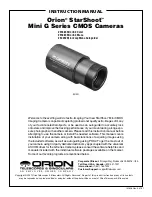
6
Mount
An equatorial mount with dual axis motors and an RJ-12 autoguide
port is required. Just about any equatorial mount equipped with an
autoguide port will work with the StarShoot Mini. The Mini is “ST-4”
compatible which uses the same pin out configuration as the first
generation CCD autoguiders. Most computerized goto mounts
also have this autoguide port. For short exposure deep space
photography (typically 45 seconds or less) the StarShoot Mini
can successfully guide with a computerized altitude-azimuth or
fork mounted telescope (as long as it includes an autoguide port),
popular among computerized Schmidt-Cassegrain telescopes.
However, guided exposures longer than one minute in an altitude-
azimuth mount will cause field rotation to occur in the image, so
an EQ mount is recommended instead.
PHD2 Guiding Software
The SS Mini along with the use of PHD2 Guiding (Push Here
Dummy) software makes the task of autoguiding simple and easy
to setup. The latest version of PHD2 can be found at:
https://openphdguiding.org/
Also, before setting up the StarShoot Mini as an Autoguider, make
sure you have downloaded and installed the ASCOM Platform
(located at
ascom-standards.org
), followed by the StarShoot
ASCOM driver (available on the Orion support page for your cam-
era). PLEASE make sure to install the ASCOM platform BEFORE
you install the ASCOM camera driver, otherwise Windows will
return an error because it cannot find the proper ASCOM direc-
tories to install this driver.
The calibration and guiding is automatic once you initially find and
focus a guide star. Your telescope must first be prepared for astro-
imaging. Make sure your mount is polar aligned well. Your guide
scope should be securely attached to your main imaging scope;
or if you are using a Schmidt-Cassegrain, the off-axis guider and
main camera should already be attached to the telescope.
PHD2 Settings
PHD2 has a detailed help file, a setup wizard, and a very active
online forum. But a few initial settings will help get the StarShoot
Mini up and running quickly as a guider. First connect the
StarShoot Mini to your guidescope (see below for some sample
connection types), attaching the USB cable between the camera
and the computer. Then connect the ST-4 phone cable between
the camera and the autoguider port on your mount. You are now
ready to connect to the system in PHD2:
1. Click the ‘Connect Equipment’ button in PHD2 to bring up
the Camera and mount selection dialog box (
Figure 6
).
For ‘Camera’ choose ‘ASCOM StarShootG Camera Driver’
from the pulldown list, and for Mount, choose ‘On Camera’.
It is important to pick this selection as this is what allows
guiding corrections via the ST-4 cable from the autoguider
to the mount. Optionally, if you also have your mount
connected via USB to the computer via an ASCOM driver,
you can choose the ASCOM mount driver under the ‘Aux
mount’ selection to provide PHD2 with pointing data from
your mount (this can be helpful when moving to different
objects so you do not have to redo the guide calibration
routine.
2. Click the little toolbox button next to the Connect button to
bring up the ASCOM properties for your camera (
Figure
7)
. Make sure in this window you are choosing the correct
camera (if you have two Orion cameras attached, one to
guide and one to image with, both may show up in this list –
make sure you have selected the autoguider). Choose the
highest bit depth, and Gain can also be adjusted, but it is
recommended to keep it between 0-10. Click ‘ok’ to go back
to the Equipment chooser, and then click ‘Connect All’
3. Choose an exposure time (usually 2-4 seconds is
appropriate) and then click ‘Begin Looping Exposures’ to
fine tune the focus and choose a guiding star. You can
also adjust the Screen Gamma slider to show fainter
background stars.
4. Refer to the PHD2 instructions for detailed setup and use
of the program.
Figure 6.
The Connect Equipment window.
Figure 5.
The USB and autoguide ports of the StarShoot Mini
Autoguider.
Autoguider Port(ST-4}
USB Port








